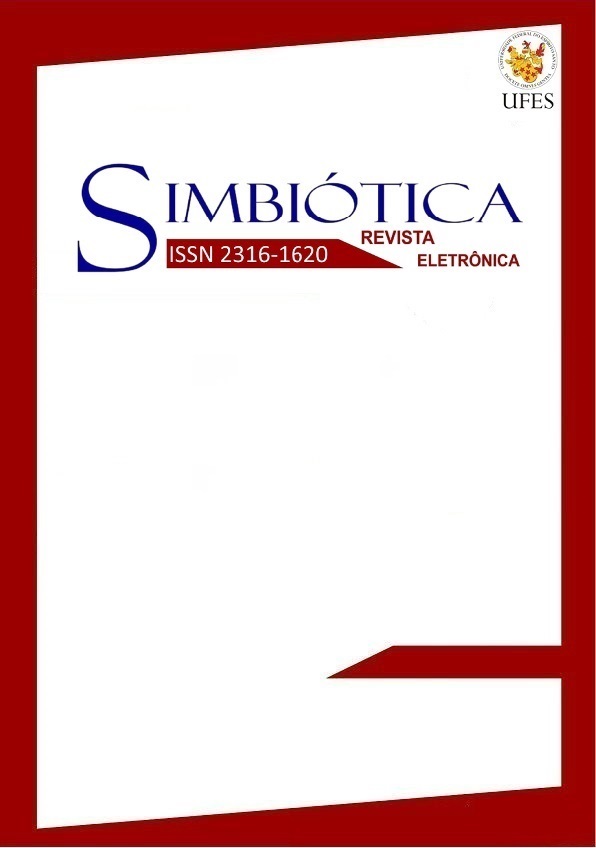O problema da perspectiva na cultura visual do Quattrocento
DOI:
https://doi.org/10.47456/simbitica.v4i1.19459Resumo
Resumo: O Renascimento ocupa lugar privilegiado na compreensão da formação do mundo moderno; menos do que um conceito fechado, o termo se constitui em espécie de topos aberto à polêmica. Nesse ensaio, ao invés da tentativa de “generalizar” uma definição de “Renascimento” que congregue elementos centrais do período, concentraremos o olhar em apenas um objeto histórico: uma tela a óleo produzida por Antonello da Messina (c.1430 – c.1479). Pela comparação direta com outras imagens, que nos permitirá percorrer alguns itinerários da prática da representação visual do período, tentaremos levantar alguns problemas relativos à História cultural vivenciados pelas sociedades italianas durante o século XV.
Palavras-chave: renascimento; história das ideias; Quattrocento; Antonello da Messina.
Resumen: El Renacimiento ocupa lugar privilegiado en la comprensión de la formación del mundo moderno; menos de un concepto cerrado, el término es cerca de convertirse en un topos abierto a controversia. El ensayo siguiente, en lugar de generalizar una definición de “Renacimiento”, centrará la vista en sólo uno objeto histórico: una pantalla de Antonello da Messina (c.1430 – c.1479). Por comparación directa con otras imágenes, que nos permitirá seguir unos itinerarios de desarrollo de la representación visual del período, trataremos de plantear algunos problemas relacionados con la historia de las ideas que experimentaron las sociedades italianas durante el siglo XV.
Palabras clave: renacimiento; historia de las Ideas; Quattrocento; Antonello da Messina.
Abstract: The Renaissance occupies a privileged place in the understanding of the formation of the modern world; less than a closed concept, the term has the character of a “topos” open to controversy. The essay, instead of trying to generalize "Renaissance", will focus in just a historic object: a oil screen produced by Antonello da Messina (c.1430 – c.1479). By direct comparison with other images, that will allow us to retrace a few itineraries of the development of the visual representation of the period, we will try to discuss some problems relating to the cultural history that the Italian societies experienced during the 15th century.
Keywords: renaissance; cultural history; Quattrocento; Antonello da Messina.
Referências
AGNOLIN, Adone (2007). Jesuítas e selvagens. São Paulo: Humanitas.
ARASSE, Daniel (1997). Léonardo da Vinci: le rythme du monde. Hazan.
______. (1999). L´annonciation italienne: une histoire de perspective. Hazan.
______. (2015). Não se vê nada. Lisboa: KKYM.
BARBERA, Gioachino (2005). Antonello da Messina. Sicily´s Renaissance Master. Yale University Press.
BLACK, Anthony (2008). “Popes and councils”. In: ALLMAND C. (Org). The new Cambridge Medieval History, vol.7. Cambridge: Cambridge University Press.
BAXANDALL, Michel (1985). L’oeil du Quattrocento. Gallimard.
CHASTEL, Andre (1999). I Centri del Rinascimento. BurArte.
EPSTEIN, Steven A. (2009). An economic and social history of Later Medieval Europe. Cambridge University Press.
FRANCASTEL, Pierre (1977). Peinture et societé: naissance et destruction d’un espace plastique. Ed. Denoel/Gonthier.
FRANCO JR, Hilário (2008). “Modelo e imagem. O pensamento analógico medieval”. In: Bulletin du centre d´études médiévales d´Auxerre, Hors e Serie n.2.
MALLET, Michael (2008). “The Northern Italian States”. In: ALLMAND, C. (Org). The new Cambridge Medieval History, vol.7. Cambridge University Press.
MURRAY, Peter (1987). Renaissance architecture. Londres: Faber and Faber.
RYDER, Alan (2008). “The papal states and the Kingdom of Naples”. In: ALLMAND, C. (Org). The new Cambridge Medieval History, vol.7. Cambridge University Press.
SKINNER, Quentin (2005). The foundations of modern political thought. Cambridge University Press.
TAFURI, Manfredo (2006). Interpreting the Renaissance: princes, cities, architects. New Haven-Londres University Press.
VASARI, Giorgio (1994). Le vite de più eccelenti architetti, pittori, et scultori italiani. Torino: Einaudi.
WEBER, Max (2001). A ética protestante e o espírito do Capitalismo. São Paulo: Centauro.
Downloads
Publicado
Edição
Seção
Licença
Copyright (c) 2020 Felipe Mendes Erra

Este trabalho está licenciado sob uma licença Creative Commons Attribution-NonCommercial-NoDerivatives 4.0 International License.
Autores que publicam nesta revista concordam com os seguintes termos:
a. Autores mantém os direitos autorais e concedem à revista o direito de primeira publicação, com o trabalho simultaneamente licenciado sob a Creative Commons - Atribuição-NãoComercial 4.0 Internacional.
b. Compartilhar - copiar e distribuir o material em qualquer meio ou formato.
Adaptar - remix, transformar e construir sobre o material para qualquer finalidade, inclusive comercial.
c. Autores têm autorização para assumir contratos adicionais separadamente, para distribuição não-exclusiva da versão do trabalho publicada nesta revista (ex.: publicar em repositório institucional ou como capítulo de livro), com reconhecimento de autoria e publicação inicial nesta revista.
d. Autores têm permissão e são estimulados a publicar e distribuir seu trabalho online (ex.: em repositórios institucionais ou na sua página pessoal) a qualquer ponto antes ou durante o processo editorial, já que isso pode gerar alterações produtivas, bem como aumentar o impacto e a citação do trabalho publicado (Veja O Efeito do Acesso Livre).
Authors who publish in this journal agree to the following terms:
a. Authors retain the copyright and grant the magazine the right of first publication, with work simultaneously licensed under the CCreative Commons - Atribuição-NãoComercial 4.0 Internacional.
b. Share - copy and distribute the material in any medium or format.
Adapt - remix, transform and build on the material for any purpose, including commercial.
c. Authors are authorized to take additional contracts separately, for non-exclusive distribution of the version of the work published in this journal (eg, publish in institutional repository or as a book chapter), with acknowledgment of authorship and initial publication in this journal.
d. Authors are allowed and encouraged to publish and distribute their work online (eg.: in institutional repositories or on their personal page) at any point before or during the editorial process, as this can generate productive changes as well as increase the impact and the citation of the published work (See The Effect of Free Access).











